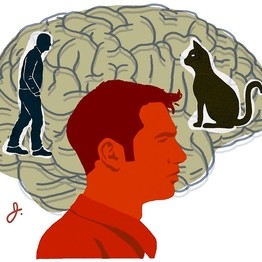(单词翻译:单击)

For the last 20 years neuroscientists have shown us compelling pictures of brain areas 'lighting up' when we see or hear, love or hate, plan or act. These studies were an important first step. But they also suggested a misleadingly simple view of how the brain works. They associated specific mental abilities with specific brain areas, in much the same way that phrenology, in the 19th century, claimed to associate psychological characteristics with skull shapes.
过去20年间,神经学家向人们展示了饶有趣味的画面:当我们在聆听或观赏、喜爱或厌恶、思考或行动时,大脑的不同区域是如何被激活的。是这些研究成果迈出了关键性的第一步,但它们对大脑简单运转方式的认知却充满了误导。这些研究认为特定脑部区域和不同心理活动相关,这一观点与19世纪的颅相学颇为相似,此学说宣称人的心理特质与颅骨形状相关。
Most people really want to understand the mind, not the brain. Why do we experience and act on the world as we do? Associating a piece of the mind with a piece of the brain does very little to answer that question. After all, for more than a century we have known that our minds are the result of the stuff between our necks and the tops of our heads. Just adding that vision is the result of stuff at the back and that planning is the result of stuff in the front, it doesn't help us understand how vision or planning work.
大多数人更想了解人的心理,而不是头脑。为什么我们对世界产生了现在这样的感知和行为?大脑某部分与心理某部分相配合的理论不大能够回答这个问题。毕竟一个多世纪以来,我们已经认识到,心理活动是源于颈部与头顶之间的那个器官。单纯认为想象力是大脑后部的产物、规划能力是大脑前部的产物并不能帮助我们理解想象力或者规划能力是怎样运转的。
But new techniques are letting researchers look at the activity of the whole brain at once. What emerges is very different from the phrenological view. In fact, most brain areas multitask; they are involved in many different kinds of experiences and actions. And the brain is dynamic. It can respond differently to the same events in different times and circumstances.
但是新技术使研究者得以同时观测整个大脑的活动,从而得出的结果与颅相学理论大为不同。事实上,大部分脑部区域都身兼数职,参与了多种多样的感知和行为。大脑非常活跃,它能够在不同的时间和空间对于相同的事件产生不同的反应。
A new study in Nature Neuroscience by Jack L. Gallant, Tolga Çukur and colleagues at the University of California, Berkeley, dramatically illustrates this new view. People in an fMRI scanner watched a half-hour-long sequence combining very short video clips of everyday scenes. The scientists organized the video content into hundreds of categories, describing whether each segment included a plant or a building, a cat or a clock.
加州大学伯克利分校(University of California, Berkeley)的杰克•L•格加伦特(Jack L. Gallant)和托尔加•丘库尔(Tolga Çukur)及其同事在《自然神经科学》(Nature Neuroscience)杂志上发表了一项新的研究,很好地诠释了这一新观点。实验对象在核磁共振仪上观看了时长半小时的视频,其中包含了关于日常生活的小片段。科学家将视频内容归为数百个种类,划分标准是每个片段中是否包含植物或者建筑、猫或者时钟,等等。
Then they divided the whole brain into small sections with a three-dimensional grid and recorded the activity in each section of the grid for each second. They used sophisticated statistical analyses to find the relationship between the patterns of brain activity and the content of the videos.
他们使用3D坐标把大脑划分为若干小区域,并且记录下每个区域每秒钟的活动情况,再采用严密的数据分析法来找到脑部活动机制和视频内容之间的关系。
The twist was that the participants either looked for human beings in the videos or looked for vehicles. When they looked for humans, great swaths of the brain became a 'human detector'─more sensitive to humans and less sensitive to vehicles. Looking for vehicles turned more of the brain into a 'vehicle detector.' And when people looked for humans their brains also became more sensitive to related objects, like cats and plants. When they looked for vehicles, their brains became more sensitive to clocks and buildings as well.
实验参与者被要求在影片中寻找人物或者交通工具。寻找人物的时候,脑部的若干区域会变为一台“人物探测器”,也就是对于人物更加敏感而对交通工具较不敏感。寻找交通工具则使脑部更像一台“交通工具探测器”。当人们在搜寻人物时,大脑也对相关的事物更为敏感,比如猫咪和植物。而搜寻交通工具时,大脑则对钟表和建筑物更为敏感。
In fact, the response patterns of most brain areas changed when people changed the focus of their attention. Something as ineffable as where you focus your attention can make your whole brain work differently.
事实上,大多数脑部区域的反应机制随着人们注意力的转移而改变。人的注意力集中在不同地方,整个大脑的运行方式也就不同。
People often assume that knowing about the brain is all that you need to explain how the mind works, so that neuroscience will replace psychology. That may account for the curious popular enthusiasm for the phrenological 'lighting up' studies. It is as if the very thought that something psychological is 'in the brain' gives us a little explanatory frisson, even though we have known for at least a century that everything psychological is 'in the brain' in some sense. But it would be just as accurate to say that knowing about the mind explains how the brain works.
人们常常理所当然地认为了解了大脑就能够解释心理活动,所以神经学将会取代心理学。这一点可以解释人们对于颅相学“激活”理论的好奇和热情。尽管从某种程度上来说,人们早在一个多世纪前就已经了解到所有心理活动都“存在于脑海里”,但这一说法仍旧无法解释清楚问题。而较为准确的说法是,了解了心理就能解释大脑如何运转。
The new, more dynamic picture of the brain makes psychology even more crucial. The researchers could only explain the very complex pattern of brain activity by relating it to what they knew about categorization and attention. In the same way, knowing the activity of every wire on every chip in my computer wouldn't tell me much if I didn't also know the program my machine was running.
这些新的、更富于动态的脑部图片令心理学变得更加重要,因为神经学研究者只能通过控制分类方法和关注点来解释复杂的脑部活动机制。这就好比,如果不知道电脑软件的运行方式,即便知道电脑硬件的每根导线如何工作也并无大用。
Neuroscience may be sexier than psychology right now, and it certainly has a lot more money and celebrity. But they really cannot get along without each other.
或许当下神经学比心理学更受关注,获得了更多经费也产生了更多名家,但是这两门学科是相互依存的。


